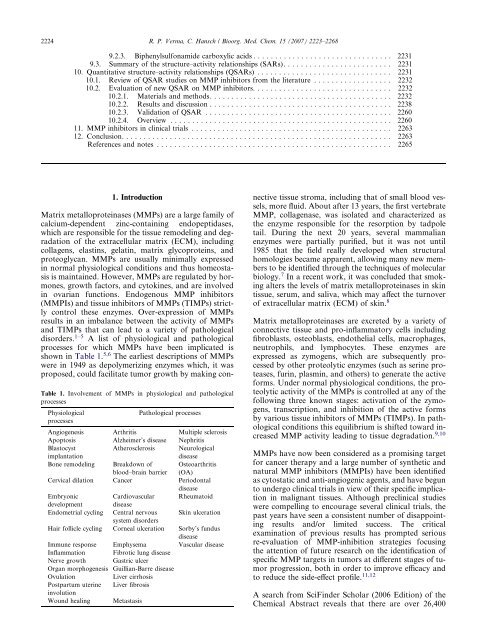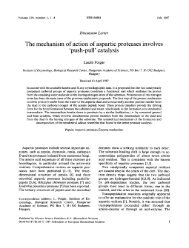Matrix metalloproteinases (MMPs): Chemical–biological functions ...
Matrix metalloproteinases (MMPs): Chemical–biological functions ...
Matrix metalloproteinases (MMPs): Chemical–biological functions ...
Create successful ePaper yourself
Turn your PDF publications into a flip-book with our unique Google optimized e-Paper software.
2224 R. P. Verma, C. Hansch / Bioorg. Med. Chem. 15 (2007) 2223–2268<br />
9.2.3. Biphenylsulfonamide carboxylic acids . . . . . . . . . . . . . . . . . . . . . . . . . . . . . . . . 2231<br />
9.3. Summary of the structure–activity relationships (SARs). . . . . . . . . . . . . . . . . . . . . . . . . 2231<br />
10. Quantitative structure–activity relationships (QSARs) . . . . . . . . . . . . . . . . . . . . . . . . . . . . . . . 2231<br />
10.1. Review of QSAR studies on MMP inhibitors from the literature . . . . . . . . . . . . . . . . . . 2232<br />
10.2. Evaluation of new QSAR on MMP inhibitors. . . . . . . . . . . . . . . . . . . . . . . . . . . . . . . . 2232<br />
10.2.1. Materials and methods. . . . . . . . . . . . . . . . . . . . . . . . . . . . . . . . . . . . . . . . . . 2232<br />
10.2.2. Results and discussion . . . . . . . . . . . . . . . . . . . . . . . . . . . . . . . . . . . . . . . . . . 2238<br />
10.2.3. Validation of QSAR . . . . . . . . . . . . . . . . . . . . . . . . . . . . . . . . . . . . . . . . . . . 2260<br />
10.2.4. Overview . . . . . . . . . . . . . . . . . . . . . . . . . . . . . . . . . . . . . . . . . . . . . . . . . . . 2260<br />
11. MMP inhibitors in clinical trials . . . . . . . . . . . . . . . . . . . . . . . . . . . . . . . . . . . . . . . . . . . . . . 2263<br />
12. Conclusion. . . . . . . . . . . . . . . . . . . . . . . . . . . . . . . . . . . . . . . . . . . . . . . . . . . . . . . . . . . . . . 2263<br />
References and notes . . . . . . . . . . . . . . . . . . . . . . . . . . . . . . . . . . . . . . . . . . . . . . . . . . . . . . 2265<br />
1. Introduction<br />
<strong>Matrix</strong> <strong>metalloproteinases</strong> (<strong>MMPs</strong>) are a large family of<br />
calcium-dependent zinc-containing endopeptidases,<br />
which are responsible for the tissue remodeling and degradation<br />
of the extracellular matrix (ECM), including<br />
collagens, elastins, gelatin, matrix glycoproteins, and<br />
proteoglycan. <strong>MMPs</strong> are usually minimally expressed<br />
in normal physiological conditions and thus homeostasis<br />
is maintained. However, <strong>MMPs</strong> are regulated by hormones,<br />
growth factors, and cytokines, and are involved<br />
in ovarian <strong>functions</strong>. Endogenous MMP inhibitors<br />
(MMPIs) and tissue inhibitors of <strong>MMPs</strong> (TIMPs) strictly<br />
control these enzymes. Over-expression of <strong>MMPs</strong><br />
results in an imbalance between the activity of <strong>MMPs</strong><br />
and TIMPs that can lead to a variety of pathological<br />
disorders. 1–5 A list of physiological and pathological<br />
processes for which <strong>MMPs</strong> have been implicated is<br />
shown in Table 1. 5,6 The earliest descriptions of <strong>MMPs</strong><br />
were in 1949 as depolymerizing enzymes which, it was<br />
proposed, could facilitate tumor growth by making con-<br />
Table 1. Involvement of <strong>MMPs</strong> in physiological and pathological<br />
processes<br />
Physiological<br />
Pathological processes<br />
processes<br />
Angiogenesis Arthritis Multiple sclerosis<br />
Apoptosis Alzheimer’s disease Nephritis<br />
Blastocyst<br />
Atherosclerosis Neurological<br />
implantation<br />
disease<br />
Bone remodeling Breakdown of Osteoarthritis<br />
blood–brain barrier (OA)<br />
Cervical dilation Cancer Periodontal<br />
disease<br />
Embryonic<br />
Cardiovascular Rheumatoid<br />
development disease<br />
Endometrial cycling Central nervous<br />
system disorders<br />
Skin ulceration<br />
Hair follicle cycling Corneal ulceration Sorby’s fundus<br />
disease<br />
Immune response Emphysema Vascular disease<br />
Inflammation Fibrotic lung disease<br />
Nerve growth Gastric ulcer<br />
Organ morphogenesis Guillian-Barre disease<br />
Ovulation Liver cirrhosis<br />
Postpartum uterine<br />
involution<br />
Liver fibrosis<br />
Wound healing Metastasis<br />
nective tissue stroma, including that of small blood vessels,<br />
more fluid. About after 13 years, the first vertebrate<br />
MMP, collagenase, was isolated and characterized as<br />
the enzyme responsible for the resorption by tadpole<br />
tail. During the next 20 years, several mammalian<br />
enzymes were partially purified, but it was not until<br />
1985 that the field really developed when structural<br />
homologies became apparent, allowing many new members<br />
to be identified through the techniques of molecular<br />
biology. 7 In a recent work, it was concluded that smoking<br />
alters the levels of matrix <strong>metalloproteinases</strong> in skin<br />
tissue, serum, and saliva, which may affect the turnover<br />
of extracellular matrix (ECM) of skin. 8<br />
<strong>Matrix</strong> <strong>metalloproteinases</strong> are excreted by a variety of<br />
connective tissue and pro-inflammatory cells including<br />
fibroblasts, osteoblasts, endothelial cells, macrophages,<br />
neutrophils, and lymphocytes. These enzymes are<br />
expressed as zymogens, which are subsequently processed<br />
by other proteolytic enzymes (such as serine proteases,<br />
furin, plasmin, and others) to generate the active<br />
forms. Under normal physiological conditions, the proteolytic<br />
activity of the <strong>MMPs</strong> is controlled at any of the<br />
following three known stages: activation of the zymogens,<br />
transcription, and inhibition of the active forms<br />
by various tissue inhibitors of <strong>MMPs</strong> (TIMPs). In pathological<br />
conditions this equilibrium is shifted toward increased<br />
MMP activity leading to tissue degradation. 9,10<br />
<strong>MMPs</strong> have now been considered as a promising target<br />
for cancer therapy and a large number of synthetic and<br />
natural MMP inhibitors (MMPIs) have been identified<br />
as cytostatic and anti-angiogenic agents, and have begun<br />
to undergo clinical trials in view of their specific implication<br />
in malignant tissues. Although preclinical studies<br />
were compelling to encourage several clinical trials, the<br />
past years have seen a consistent number of disappointing<br />
results and/or limited success. The critical<br />
examination of previous results has prompted serious<br />
re-evaluation of MMP-inhibition strategies focusing<br />
the attention of future research on the identification of<br />
specific MMP targets in tumors at different stages of tumor<br />
progression, both in order to improve efficacy and<br />
to reduce the side-effect profile. 11,12<br />
A search from SciFinder Scholar (2006 Edition) of the<br />
Chemical Abstract reveals that there are over 26,400



